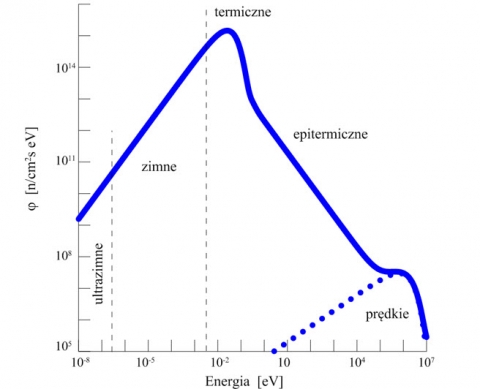The energy spectrum of neutrons in a reactor
The neutrons emitted during the fissioning have energies of a few megaelectron volts and are referred to as fast neutrons (Figure 1). As a result of collisions with the nuclei of the medium, mainly the moderator, a region of epithermal neutrons with a characteristic dependence on the energy of the 1/E type appears in the spectrum of neutrons. After reaching the energy of a dozen or so meV, the state of thermodynamic equilibrium is established between the neutron energies and the thermal vibration energies of the medium. Hence the name: thermal neutrons. In this region, the neutron energy spectrum is characterized by the Maxwell distribution. Due to the fact that they are used for physical research in the field of low energies, areas of cold and ultracold neutrons are also separated.
Neutrons from all energy ranges find their application. Fast neutrons in the so-called threshold reactions, i. e. nuclear reactions that take place with the participation of neutrons with a certain minimum threshold energy. In the neutron energy region above 0.1 eV resonance reactions take place, the cross sections of which have a characteristic, resonant character. Thermal neutrons are most commonly used in radiation capture reactions; the cross-sections of these reactions most often have a characteristic course of the 1/v type.
The de Broglie wavelengths of thermal neutrons are comparable to the interatomic distances in a solid and hence the widespread use of these neutrons for research in the field of condensed matter physics.













